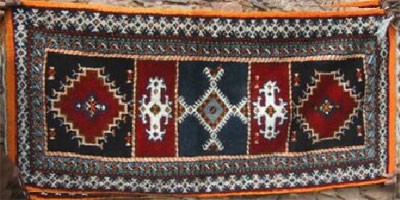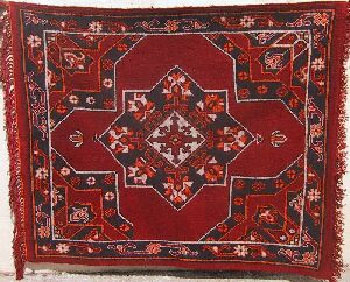Morocco has a rich and varied weaving tradition. In villages in the Atlas Mountains, Berber tribes are known for their woven rugs.
In the village of N'kob in the High Atlas Mountains of southern Morocco, women weave five kinds of rugs. The High Atlas weavers make flatweave rugs, which are call kilims, and pile or knotted rugs, as well as combinations of the two. The colors are often rich reds and blues with gold accents. Some styles use much black and white, sometimes with accents in colors made from vegetable dyes.
Chedwis are flatweaves with plain black and white stripes, patterned black and white stripes made in a different technique called twining, and stripes with colors that often come from natural dyes. These are probably the oldest style of rugs, and few are woven anymore. Chedwis are among the few pieces where weavers use fibers with natural dyes.
The village of N'kob Ait Ourghrda is south of Ouarzazate and north of Tazenakht in the High Atlas. It has a population of 670, and the women there are considered among the best weavers in southern Morocco. The wool that comes from sheep in this mountain region is of long fibre and very high quality.
The Tazenakht style is probably the best-known style from this area.
The village of Ben Smim is an agricultural area in the Middle Atlas Mountains an hour south of Fez. At least five variations of rugs, coverlets or wall hangings are woven here.
In the Middle Atlas they also make flatwoven and pile rugs, but usually do not combine the two. Their flatwoven rugs may have an overall pattern of large diamonds, or of plain colored stripes interspersed with design stripes. The pile rugs often can be used on two sides, the flat one in the summer and the fuzzy one for warmth in the winter. A unique characteristic is that they sew sequins onto the rugs.
A flatwoven piece with an overall design of large diamonds, with sequins
Source: http://d2ssd.com/www-source/weaversoverview.html




